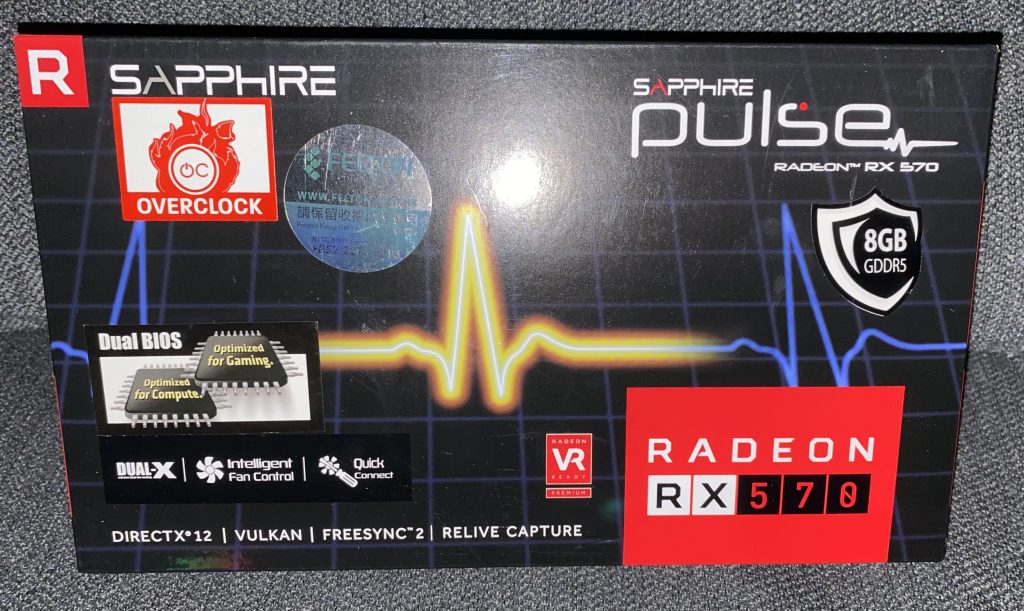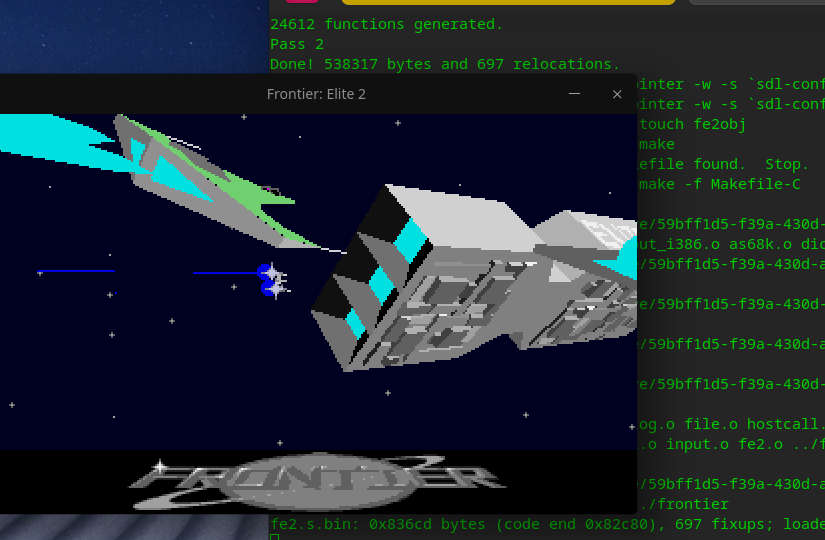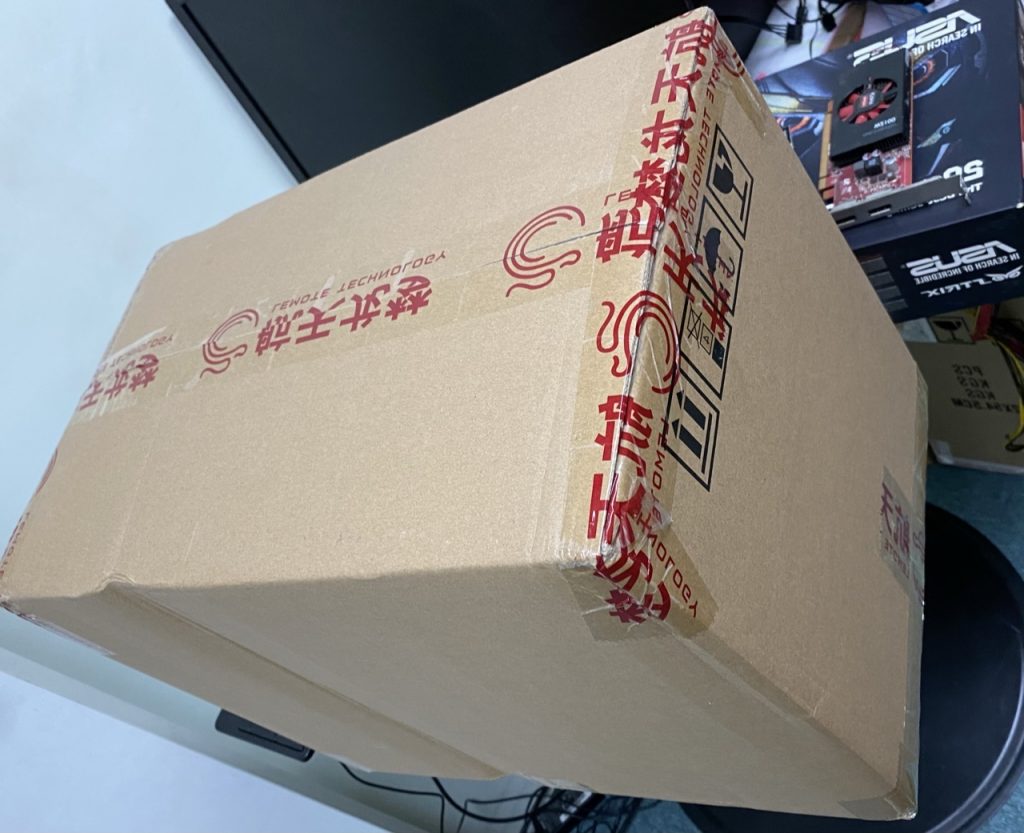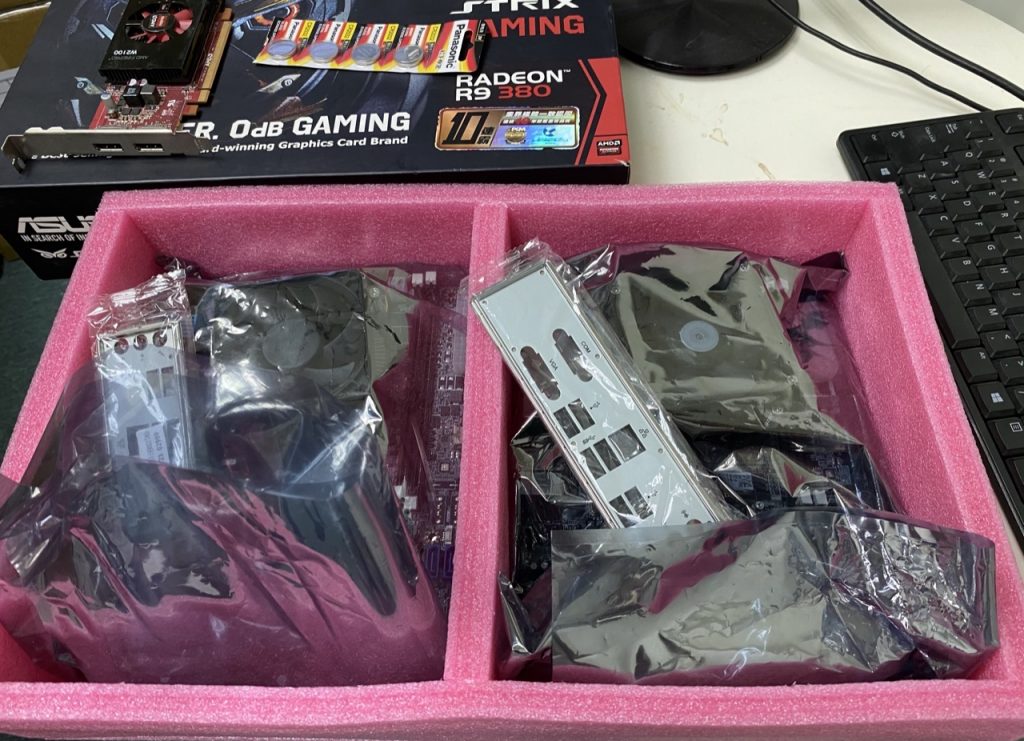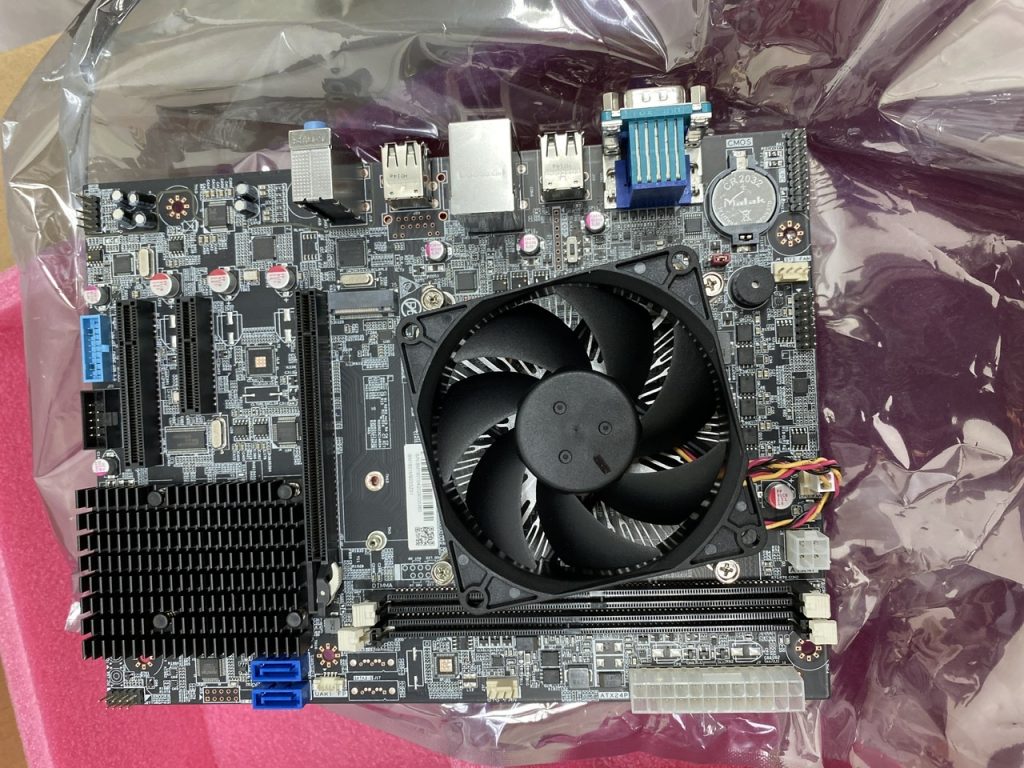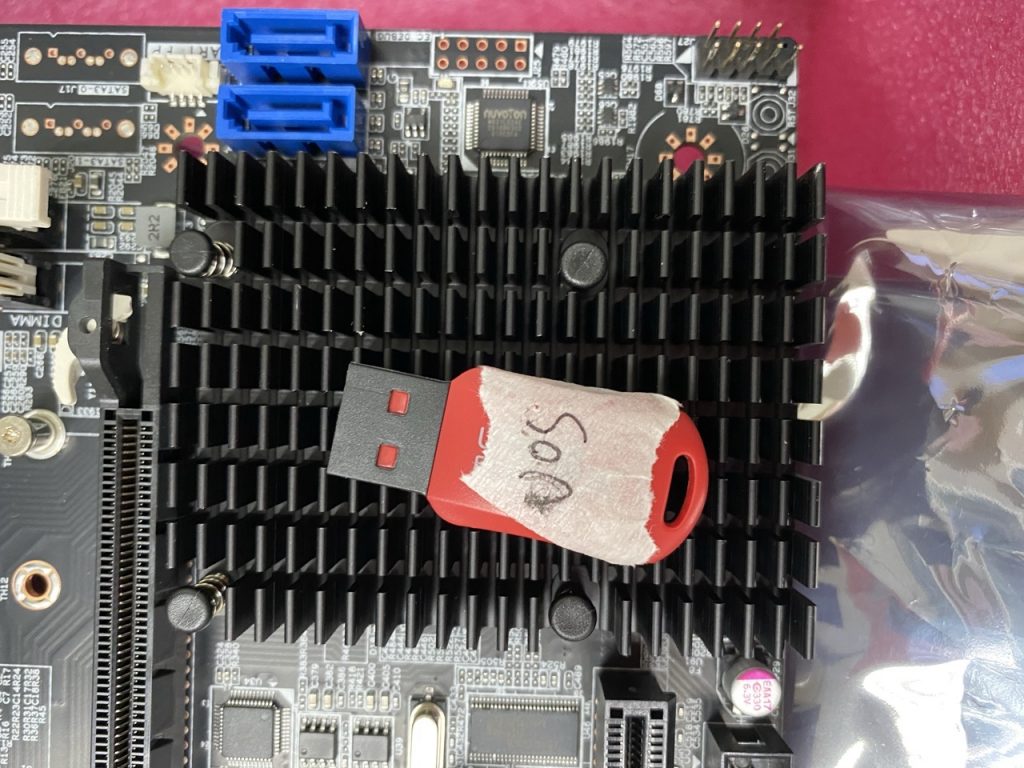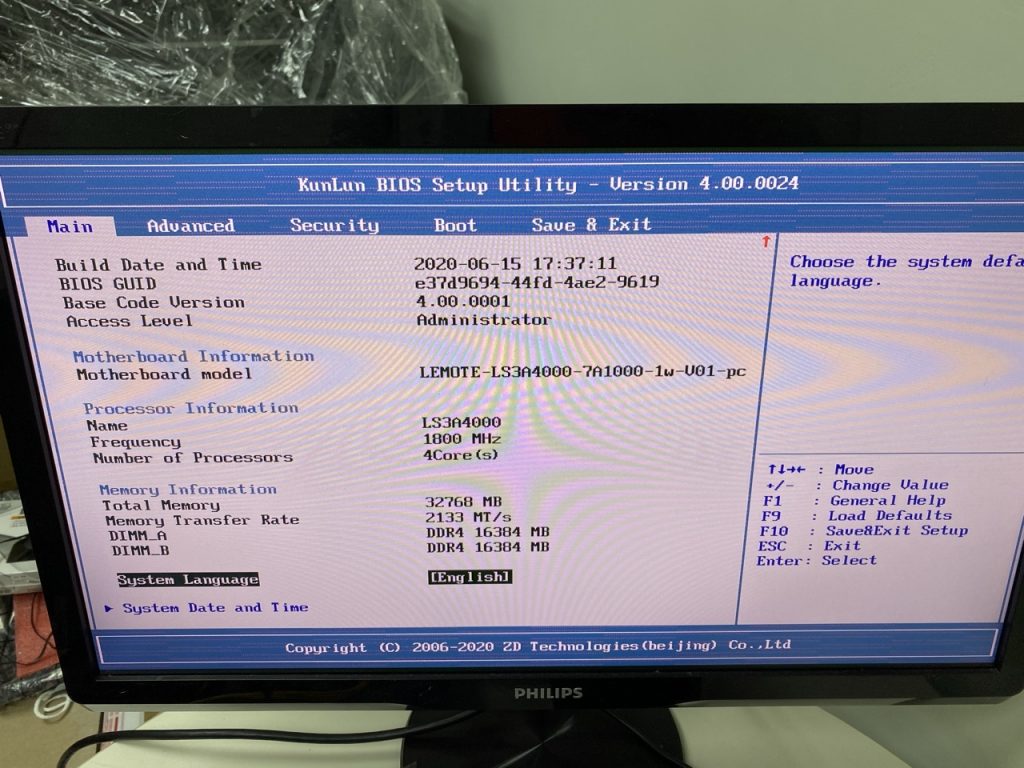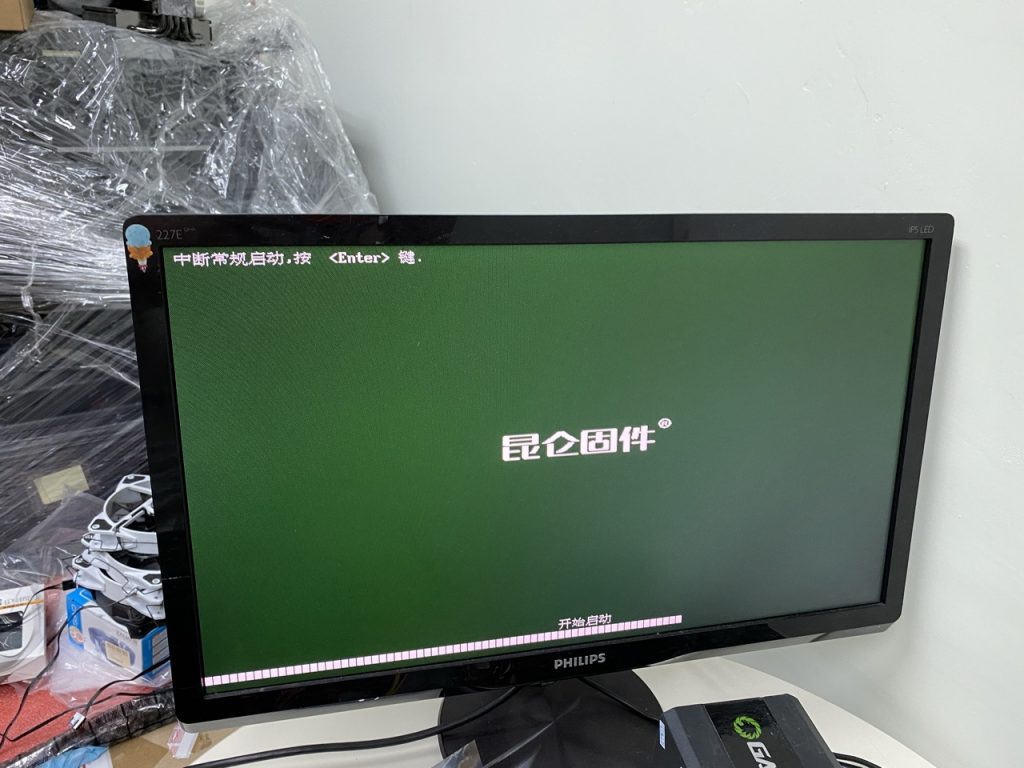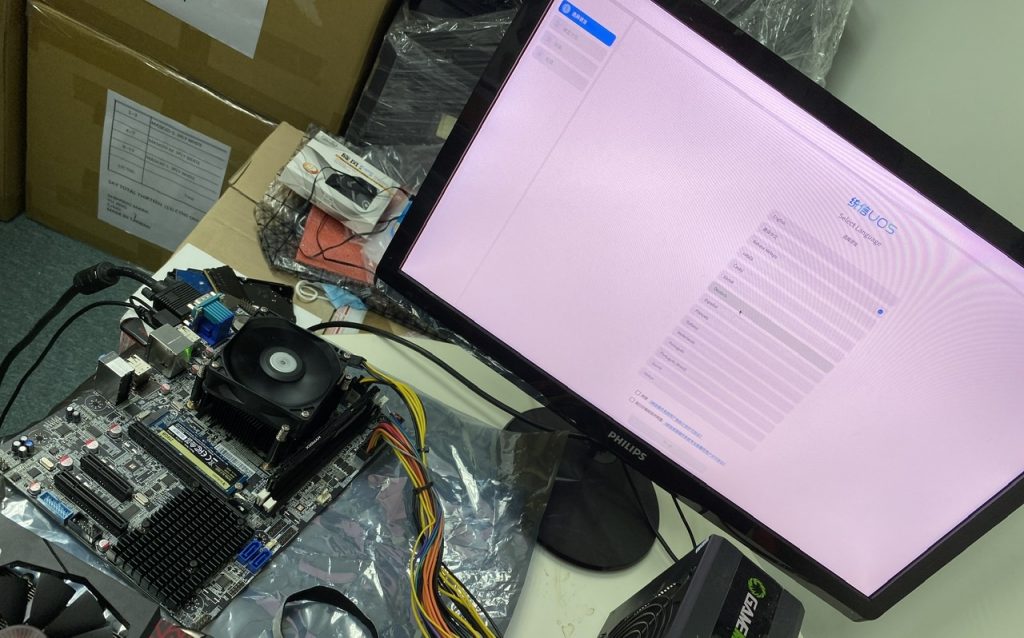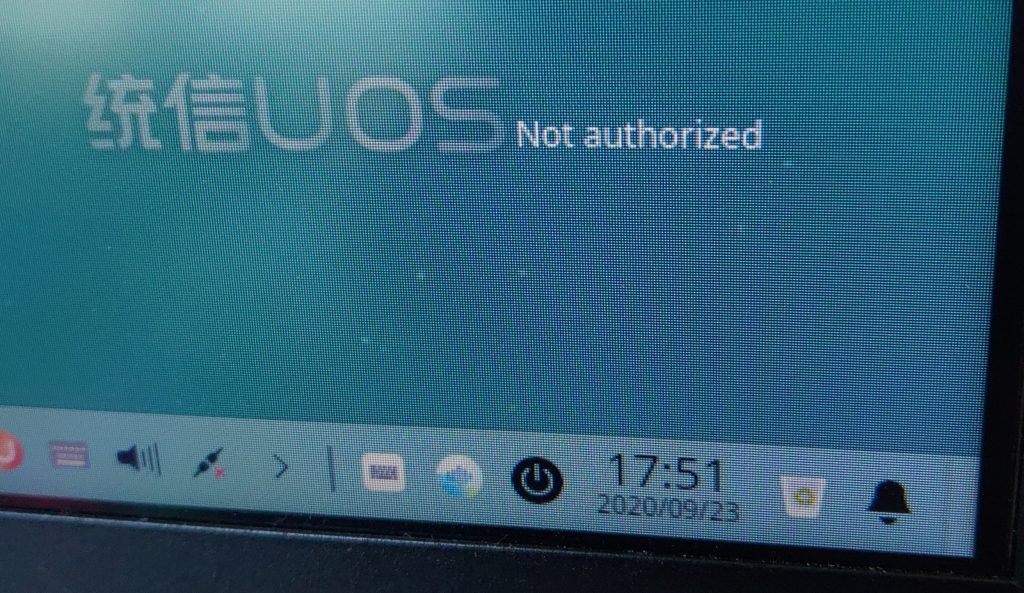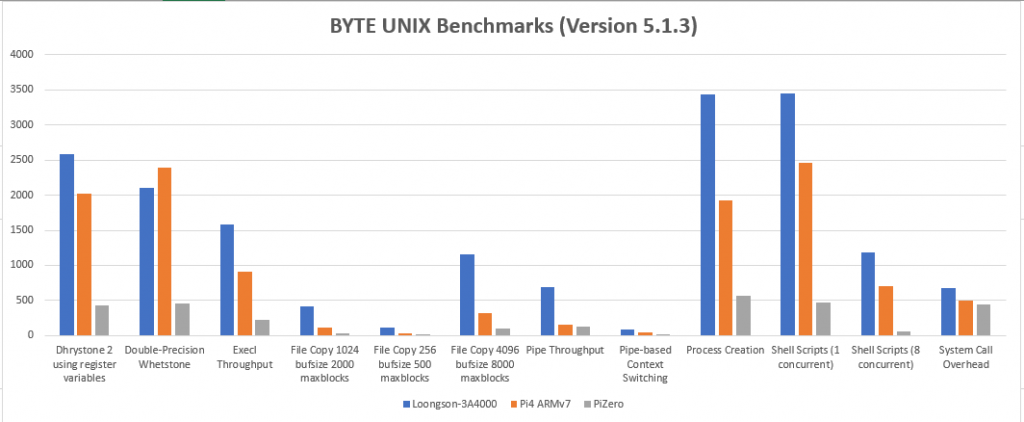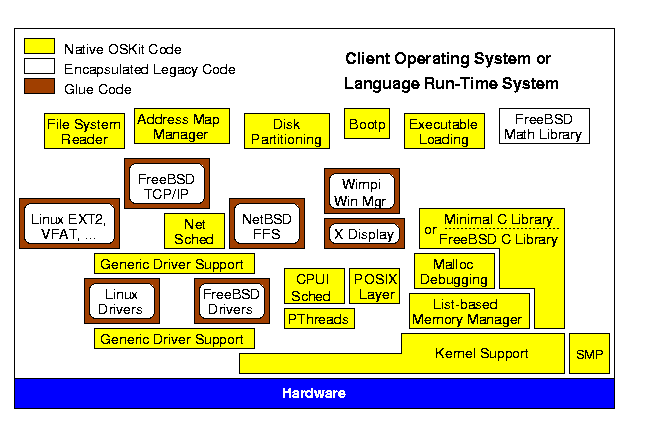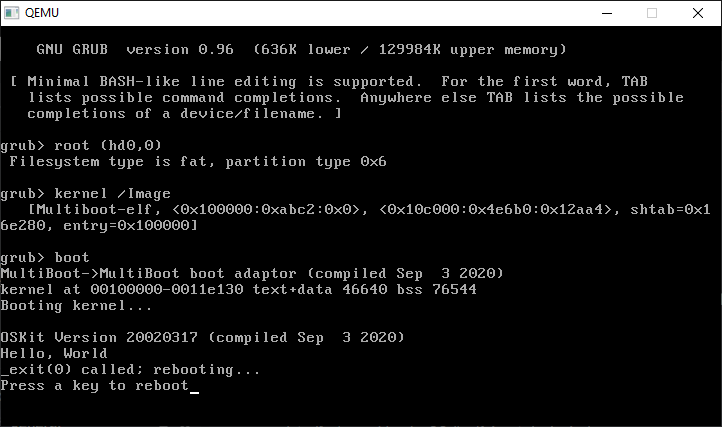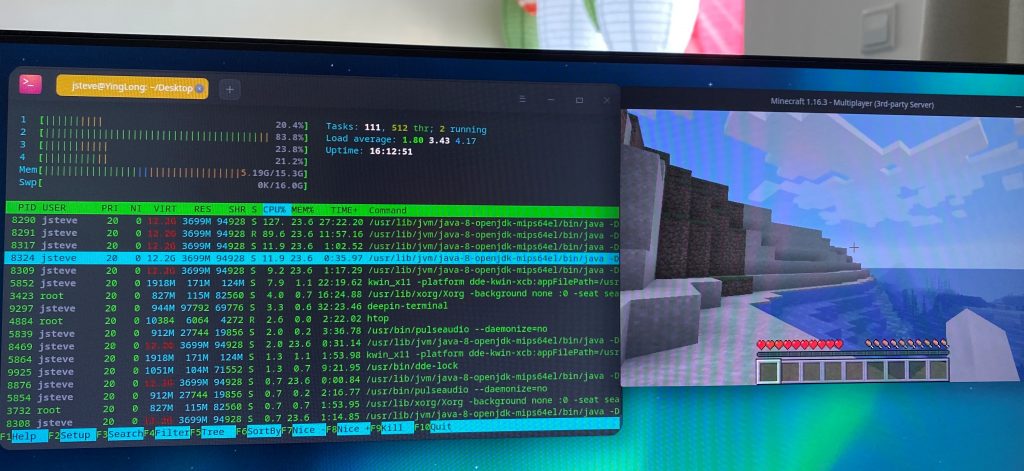
This was a bit more work than I had anticipated. However flygoat had done much of the legwork for me. The first thing to get is flygoat’s mc-loongson.zip. I made a local download as I suspect many will not have QQ or WeChat (Or don’t want to admit to the government that you are downloading this…).
I’m not sure if it’s a MIPS thing or a UOS thing, but it had Java 11.0.4 in by default, which is CRAZY slow
$ /usr/lib/jvm/java-1.11.0-openjdk-mips64el/bin/java -version
openjdk version "11.0.4" 2019-07-16
OpenJDK Runtime Environment (build 11.0.4+11-post-Debian-1deb10u1)
OpenJDK 64-Bit Zero VM (build 11.0.4+11-post-Debian-1deb10u1, interpreted mode)I installed version 8, but they are ‘in parallel’ in different directories… I guess it’s the .net hell drift all over again. Although to be fair I’ve only dealt with vendor installed java on Linux where it’s all fixed to single versions.
/usr/lib/jvm/java-1.11.0-openjdk-mips64el/bin/java --module-path /usr/share/openjfx/lib --add-modules=javafx.controls,javafx.fxml,javafx.base,javafx.media,javafx.web,javafx.swing -jar HMCL-3.2.139.jarOne annoying thing is that it cannot find JavaFX over and over despite it being installed, so I had to manually add the ‘module-path’. This is the syntax for version 11, I’m not all that sure on the version 8 syntax.
$ /usr/lib/jvm/java-8-openjdk-mips64el/bin/java -version
openjdk version "1.8.0"
OpenJDK Runtime Environment (Loongson 8.1.3-mips64r2-uos) (build 1.8.0-1.8.0.212-2deepin-b00)
OpenJDK 64-Bit Server VM (build 25.71-b00, mixed mode)I changed the /etc/alternatives/java to point to version 8, which although causes the launcher to crash launching the actual exe, it’s trivial enough to change it to version 8. Although the command is… unwieldy but save it to a shell script.
I’m sure it won’t paste well, but here we go.. and it’s in my homedir sooo here we go!
/usr/lib/jvm/java-8-openjdk-mips64el/bin/java “-Dminecraft.client.jar=.minecraft/versions/1.15.2/1.15.2.jar” “-Duser.home=null” -XX:+UnlockExperimentalVMOptions -XX:+UseG1GC “-XX:G1NewSizePercent=20” “-XX:G1ReservePercent=20” “-XX:MaxGCPauseMillis=50” “-XX:G1HeapRegionSize=16M” -XX:-UseAdaptiveSizePolicy -XX:-OmitStackTraceInFastThrow -Xmn128m -Xmx7936m “-Dfml.ignoreInvalidMinecraftCertificates=true” “-Dfml.ignorePatchDiscrepancies=true” “-Djava.library.path=/home/neozeed/mc-loongson/.minecraft/versions/1.15.2/1.15.2-natives” “-Dminecraft.launcher.brand=HMCL” “-Dminecraft.launcher.version=3.2.139” -cp /home/neozeed/mc-loongson/.minecraft/libraries/com/mojang/patchy/1.1/patchy-1.1.jar:/home/neozeed/mc-loongson/.minecraft/libraries/oshi-project/oshi-core/1.1/oshi-core-1.1.jar:/home/neozeed/mc-loongson/.minecraft/libraries/net/java/dev/jna/jna/4.4.0/jna-4.4.0.jar:/home/neozeed/mc-loongson/.minecraft/libraries/net/java/dev/jna/platform/3.4.0/platform-3.4.0.jar:/home/neozeed/mc-loongson/.minecraft/libraries/com/ibm/icu/icu4j/66.1/icu4j-66.1.jar:/home/neozeed/mc-loongson/.minecraft/libraries/com/mojang/javabridge/1.0.22/javabridge-1.0.22.jar:/home/neozeed/mc-loongson/.minecraft/libraries/net/sf/jopt-simple/jopt-simple/5.0.3/jopt-simple-5.0.3.jar:/home/neozeed/mc-loongson/.minecraft/libraries/io/netty/netty-all/4.1.25.Final/netty-all-4.1.25.Final.jar:/home/neozeed/mc-loongson/.minecraft/libraries/com/google/guava/guava/21.0/guava-21.0.jar:/home/neozeed/mc-loongson/.minecraft/libraries/org/apache/commons/commons-lang3/3.5/commons-lang3-3.5.jar:/home/neozeed/mc-loongson/.minecraft/libraries/commons-io/commons-io/2.5/commons-io-2.5.jar:/home/neozeed/mc-loongson/.minecraft/libraries/commons-codec/commons-codec/1.10/commons-codec-1.10.jar:/home/neozeed/mc-loongson/.minecraft/libraries/net/java/jinput/jinput/2.0.5/jinput-2.0.5.jar:/home/neozeed/mc-loongson/.minecraft/libraries/net/java/jutils/jutils/1.0.0/jutils-1.0.0.jar:/home/neozeed/mc-loongson/.minecraft/libraries/com/mojang/brigadier/1.0.17/brigadier-1.0.17.jar:/home/neozeed/mc-loongson/.minecraft/libraries/com/mojang/datafixerupper/4.0.26/datafixerupper-4.0.26.jar:/home/neozeed/mc-loongson/.minecraft/libraries/com/google/code/gson/gson/2.8.0/gson-2.8.0.jar:/home/neozeed/mc-loongson/.minecraft/libraries/com/mojang/authlib/1.6.25/authlib-1.6.25.jar:/home/neozeed/mc-loongson/.minecraft/libraries/org/apache/commons/commons-compress/1.8.1/commons-compress-1.8.1.jar:/home/neozeed/mc-loongson/.minecraft/libraries/org/apache/httpcomponents/httpclient/4.3.3/httpclient-4.3.3.jar:/home/neozeed/mc-loongson/.minecraft/libraries/commons-logging/commons-logging/1.1.3/commons-logging-1.1.3.jar:/home/neozeed/mc-loongson/.minecraft/libraries/org/apache/httpcomponents/httpcore/4.3.2/httpcore-4.3.2.jar:/home/neozeed/mc-loongson/.minecraft/libraries/it/unimi/dsi/fastutil/8.2.1/fastutil-8.2.1.jar:/home/neozeed/mc-loongson/.minecraft/libraries/org/apache/logging/log4j/log4j-api/2.8.1/log4j-api-2.8.1.jar:/home/neozeed/mc-loongson/.minecraft/libraries/org/apache/logging/log4j/log4j-core/2.8.1/log4j-core-2.8.1.jar:/home/neozeed/mc-loongson/.minecraft/libraries/org/lwjgl/lwjgl/3.2.2/lwjgl-3.2.2.jar:/home/neozeed/mc-loongson/.minecraft/libraries/org/lwjgl/lwjgl-jemalloc/3.2.2/lwjgl-jemalloc-3.2.2.jar:/home/neozeed/mc-loongson/.minecraft/libraries/org/lwjgl/lwjgl-openal/3.2.2/lwjgl-openal-3.2.2.jar:/home/neozeed/mc-loongson/.minecraft/libraries/org/lwjgl/lwjgl-opengl/3.2.2/lwjgl-opengl-3.2.2.jar:/home/neozeed/mc-loongson/.minecraft/libraries/org/lwjgl/lwjgl-glfw/3.2.2/lwjgl-glfw-3.2.2.jar:/home/neozeed/mc-loongson/.minecraft/libraries/org/lwjgl/lwjgl-stb/3.2.2/lwjgl-stb-3.2.2.jar:/home/neozeed/mc-loongson/.minecraft/libraries/org/lwjgl/lwjgl-tinyfd/3.2.2/lwjgl-tinyfd-3.2.2.jar:/home/neozeed/mc-loongson/.minecraft/libraries/com/mojang/text2speech/1.11.3/text2speech-1.11.3.jar:/home/neozeed/mc-loongson/.minecraft/libraries/com/ibm/icu/icu4j-core-mojang/51.2/icu4j-core-mojang-51.2.jar:/home/neozeed/mc-loongson/.minecraft/libraries/org/lwjgl/lwjgl/3.2.2/lwjgl-3.2.2.jar:/home/neozeed/mc-loongson/.minecraft/libraries/org/lwjgl/lwjgl-jemalloc/3.2.2/lwjgl-jemalloc-3.2.2.jar:/home/neozeed/mc-loongson/.minecraft/libraries/org/lwjgl/lwjgl-openal/3.2.2/lwjgl-openal-3.2.2.jar:/home/neozeed/mc-loongson/.minecraft/libraries/org/lwjgl/lwjgl-opengl/3.2.2/lwjgl-opengl-3.2.2.jar:/home/neozeed/mc-loongson/.minecraft/libraries/org/lwjgl/lwjgl-glfw/3.2.2/lwjgl-glfw-3.2.2.jar:/home/neozeed/mc-loongson/.minecraft/libraries/org/lwjgl/lwjgl-stb/3.2.2/lwjgl-stb-3.2.2.jar:/home/neozeed/mc-loongson/.minecraft/libraries/org/lwjgl/lwjgl-tinyfd/3.2.2/lwjgl-tinyfd-3.2.2.jar:/home/neozeed/mc-loongson/.minecraft/versions/1.15.2/1.15.2.jar “-Djava.library.path=/home/neozeed/mc-loongson/.minecraft/versions/1.15.2/1.15.2-natives” “-Dminecraft.launcher.brand=HMCL” “-Dminecraft.launcher.version=3.2.139” -cp /home/neozeed/mc-loongson/.minecraft/libraries/com/mojang/patchy/1.1/patchy-1.1.jar:/home/neozeed/mc-loongson/.minecraft/libraries/oshi-project/oshi-core/1.1/oshi-core-1.1.jar:/home/neozeed/mc-loongson/.minecraft/libraries/net/java/dev/jna/jna/4.4.0/jna-4.4.0.jar:/home/neozeed/mc-loongson/.minecraft/libraries/net/java/dev/jna/platform/3.4.0/platform-3.4.0.jar:/home/neozeed/mc-loongson/.minecraft/libraries/com/ibm/icu/icu4j/66.1/icu4j-66.1.jar:/home/neozeed/mc-loongson/.minecraft/libraries/com/mojang/javabridge/1.0.22/javabridge-1.0.22.jar:/home/neozeed/mc-loongson/.minecraft/libraries/net/sf/jopt-simple/jopt-simple/5.0.3/jopt-simple-5.0.3.jar:/home/neozeed/mc-loongson/.minecraft/libraries/io/netty/netty-all/4.1.25.Final/netty-all-4.1.25.Final.jar:/home/neozeed/mc-loongson/.minecraft/libraries/com/google/guava/guava/21.0/guava-21.0.jar:/home/neozeed/mc-loongson/.minecraft/libraries/org/apache/commons/commons-lang3/3.5/commons-lang3-3.5.jar:/home/neozeed/mc-loongson/.minecraft/libraries/commons-io/commons-io/2.5/commons-io-2.5.jar:/home/neozeed/mc-loongson/.minecraft/libraries/commons-codec/commons-codec/1.10/commons-codec-1.10.jar:/home/neozeed/mc-loongson/.minecraft/libraries/net/java/jinput/jinput/2.0.5/jinput-2.0.5.jar:/home/neozeed/mc-loongson/.minecraft/libraries/net/java/jutils/jutils/1.0.0/jutils-1.0.0.jar:/home/neozeed/mc-loongson/.minecraft/libraries/com/mojang/brigadier/1.0.17/brigadier-1.0.17.jar:/home/neozeed/mc-loongson/.minecraft/libraries/com/mojang/datafixerupper/4.0.26/datafixerupper-4.0.26.jar:/home/neozeed/mc-loongson/.minecraft/libraries/com/google/code/gson/gson/2.8.0/gson-2.8.0.jar:/home/neozeed/mc-loongson/.minecraft/libraries/com/mojang/authlib/1.6.25/authlib-1.6.25.jar:/home/neozeed/mc-loongson/.minecraft/libraries/org/apache/commons/commons-compress/1.8.1/commons-compress-1.8.1.jar:/home/neozeed/mc-loongson/.minecraft/libraries/org/apache/httpcomponents/httpclient/4.3.3/httpclient-4.3.3.jar:/home/neozeed/mc-loongson/.minecraft/libraries/commons-logging/commons-logging/1.1.3/commons-logging-1.1.3.jar:/home/neozeed/mc-loongson/.minecraft/libraries/org/apache/httpcomponents/httpcore/4.3.2/httpcore-4.3.2.jar:/home/neozeed/mc-loongson/.minecraft/libraries/it/unimi/dsi/fastutil/8.2.1/fastutil-8.2.1.jar:/home/neozeed/mc-loongson/.minecraft/libraries/org/apache/logging/log4j/log4j-api/2.8.1/log4j-api-2.8.1.jar:/home/neozeed/mc-loongson/.minecraft/libraries/org/apache/logging/log4j/log4j-core/2.8.1/log4j-core-2.8.1.jar:/home/neozeed/mc-loongson/.minecraft/libraries/org/lwjgl/lwjgl/3.2.2/lwjgl-3.2.2.jar:/home/neozeed/mc-loongson/.minecraft/libraries/org/lwjgl/lwjgl-jemalloc/3.2.2/lwjgl-jemalloc-3.2.2.jar:/home/neozeed/mc-loongson/.minecraft/libraries/org/lwjgl/lwjgl-openal/3.2.2/lwjgl-openal-3.2.2.jar:/home/neozeed/mc-loongson/.minecraft/libraries/org/lwjgl/lwjgl-opengl/3.2.2/lwjgl-opengl-3.2.2.jar:/home/neozeed/mc-loongson/.minecraft/libraries/org/lwjgl/lwjgl-glfw/3.2.2/lwjgl-glfw-3.2.2.jar:/home/neozeed/mc-loongson/.minecraft/libraries/org/lwjgl/lwjgl-stb/3.2.2/lwjgl-stb-3.2.2.jar:/home/neozeed/mc-loongson/.minecraft/libraries/org/lwjgl/lwjgl-tinyfd/3.2.2/lwjgl-tinyfd-3.2.2.jar:/home/neozeed/mc-loongson/.minecraft/libraries/com/mojang/text2speech/1.11.3/text2speech-1.11.3.jar:/home/neozeed/mc-loongson/.minecraft/libraries/com/ibm/icu/icu4j-core-mojang/51.2/icu4j-core-mojang-51.2.jar:/home/neozeed/mc-loongson/.minecraft/libraries/org/lwjgl/lwjgl/3.2.2/lwjgl-3.2.2.jar:/home/neozeed/mc-loongson/.minecraft/libraries/org/lwjgl/lwjgl-jemalloc/3.2.2/lwjgl-jemalloc-3.2.2.jar:/home/neozeed/mc-loongson/.minecraft/libraries/org/lwjgl/lwjgl-openal/3.2.2/lwjgl-openal-3.2.2.jar:/home/neozeed/mc-loongson/.minecraft/libraries/org/lwjgl/lwjgl-opengl/3.2.2/lwjgl-opengl-3.2.2.jar:/home/neozeed/mc-loongson/.minecraft/libraries/org/lwjgl/lwjgl-glfw/3.2.2/lwjgl-glfw-3.2.2.jar:/home/neozeed/mc-loongson/.minecraft/libraries/org/lwjgl/lwjgl-stb/3.2.2/lwjgl-stb-3.2.2.jar:/home/neozeed/mc-loongson/.minecraft/libraries/org/lwjgl/lwjgl-tinyfd/3.2.2/lwjgl-tinyfd-3.2.2.jar:/home/neozeed/mc-loongson/.minecraft/versions/1.15.2/1.15.2.jar net.minecraft.client.main.Main –username USERNAME –version “HMCL 3.2.139” –gameDir /home/neozeed/mc-loongson/.minecraft –assetsDir /home/neozeed/mc-loongson/.minecraft/assets –assetIndex 1.16 –uuid UUID –accessToken TOOOOKENNNNNN –userType mojang –versionType “HMCL 3.2.139” –width 854 –height 480
Naturally you’ll need your own username, token, uuid..
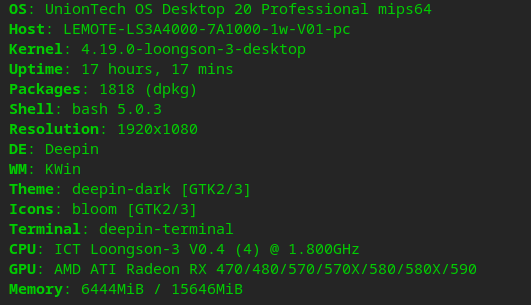
One thing is for sure, setting the graphics to higher details gives better performance. I suspect that it’s a matter of pushing more of the rendering to hardware, out of software mode.
I have it set to Fabulous! graphics, render distance of 25 chunks, no vysnc, clouds fast, mipmap level 2.
While it does take a while to load up, join the server, and do the initial world loading, you can watch all 4 cores run at 100%, but once it’s loaded in, it’s down to a single core at 100%, and the other 3 are hovering around 10-25%. So once jit’d and loaded in it seems to run okay.
They are jackhammering downstairs and I could make this 1 minute clip in a brief moment of peace. This is before I figured out that the more acceleration you give Minecraft, the faster it runs with the GPU doing the heavy lifting (I think).
Is this the machine for the Minecraft enthusiast? Hardly, but Minecraft is the Java success story, where a platform like this, a fringe non mainstream platform will run a commercial app. This is where the real portability of binutils/gcc/libc and Linux prove to be the winning platform.

